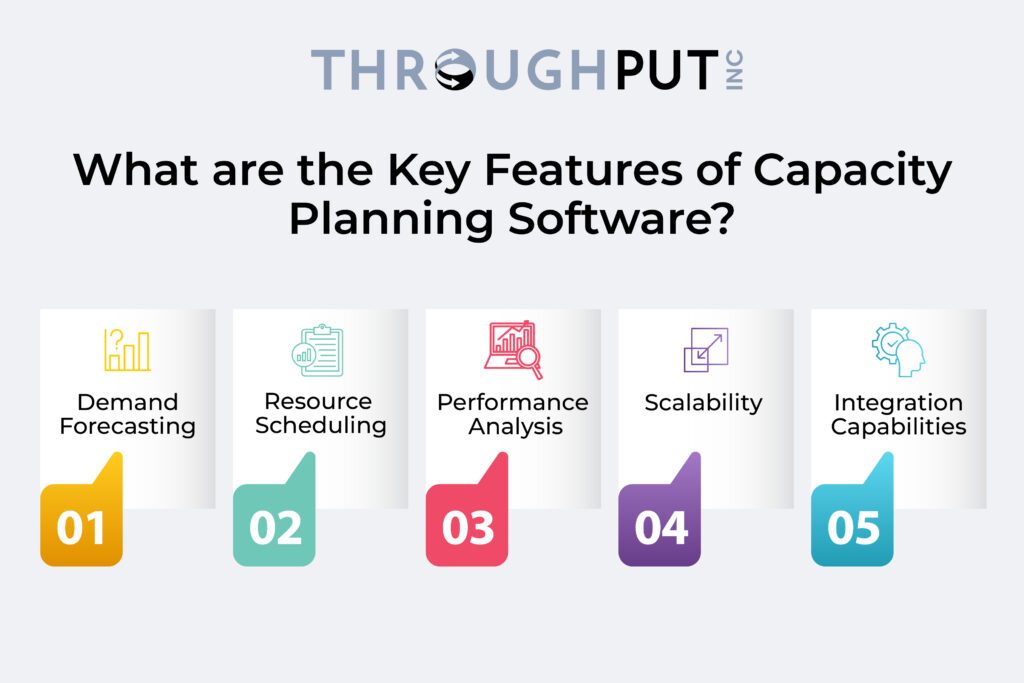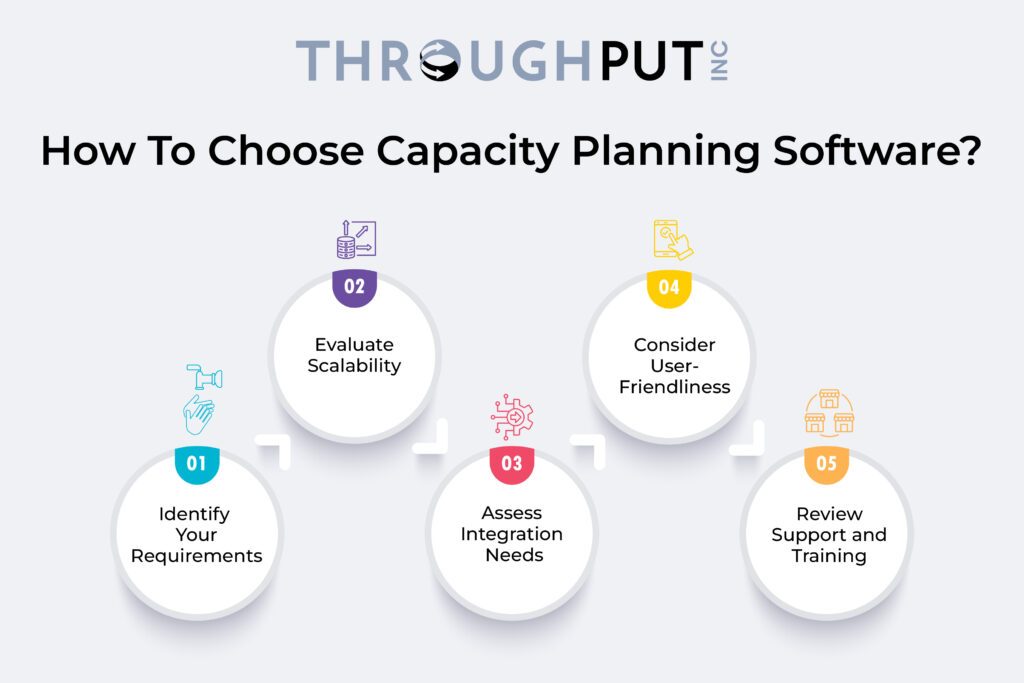Capacity Planning Software – Plan, Analyze and Prepare for Capacity

Capacity planning software is an advanced tool designed to assist businesses in managing their resources effectively to meet future workloads and demands.
However, organizations often face costly challenges such as ensuring data quality and integration, managing change, and evaluating the cost and ROI of the software implementation.
This guide is a deep dive into the essence of capacity planning software, its benefits, key features to look for, and how to choose the right capacity planning software for your company or supply chain.
What is Capacity Planning Software?
Capacity planning software is a programmable solution that helps manufacturing organizations understand the actual production capacity needed to address fluctuating demands for its products and services.
Its primary goal is to ensure that an organization can effectively meet its future workload and demand planning without the pitfalls of resource overextension or underutilization.
Capacity planning software goes beyond scheduling and resource allocation; it forecasts demand, optimizes resource utilization, and provides actionable insights into performance metrics.
This software offers a panoramic view of an organization’s resource capabilities and limitations.
It analyzes historical data, current trends, and future projections to identify patterns, predict potential bottlenecks, and suggest optimal solutions for resource allocation.
Moreover, capacity planning software provides a platform for performance analysis, enabling organizations to monitor and evaluate the effectiveness of their resource management strategies.
What are the Key Features of Capacity Planning Software?
The key features of capacity planning software are demand forecasting, resource scheduling, performance analysis, and integration capabilities.
When selecting capacity planning software, prioritize features that enhance demand forecasting, resource scheduling, and performance analysis while ensuring the software is scalable and integrates well with your existing systems.
The software you choose should not only address your current needs but also grow with your business, adapting to changing demands and complexities.
Here are the essential features to consider when selecting capacity planning software:

Key Feature 1: Demand Forecasting
The best capacity planning software is equipped with advanced demand forecasting tools that analyze historical data, market trends, and other relevant factors to predict future needs.
These tools use sophisticated algorithms to identify patterns and trends, enabling businesses to make informed decisions about resource allocation.
The aim is to balance supply and demand effectively, minimizing the risk of resource overallocation or shortages.
Key Feature 2: Resource Scheduling
Resource scheduling functionality allows managers to allocate and schedule resources efficiently, ensuring that the right resources are available when and where they are needed.
Effective resource scheduling helps optimize the utilization of resources, reduce idle times, and ensure projects are completed within deadlines.
Look for software that provides a user-friendly scheduling interface and the flexibility to adjust resources as project scopes or priorities change.
Key Feature 3: Performance Analysis
Capacity planning software should offer comprehensive performance analytics to continuously improve resource utilization.
These analytics help identify areas of over or underutilization, enabling managers to make data-driven decisions to optimize resource allocation.
Performance analysis features should include customizable reports and dashboards that provide insights into key performance indicators (KPIs), such as resource utilization rates, project completion times, and cost efficiencies.
Key Feature 4: Scalability
As businesses grow, their capacity planning needs become more complex.
The software you choose should be scalable and capable of handling increased data volumes, more complex projects, and a greater number of resources without compromising on performance.
Scalability ensures that your capacity planning software can adapt as your business expands, providing continued support for efficient resource management.
Key Feature 5: Integration Capabilities
For a comprehensive view of your operations, capacity planning software must seamlessly integrate with other business systems, such as ERP (Enterprise Resource Planning), CRM (Customer Relationship Management), and project management tools.
Integration ensures consistency in data across different platforms, enhancing the accuracy of capacity planning. It also facilitates information sharing between departments, improving collaboration and decision-making.
These features are fundamental to optimizing resource management processes, improving efficiency, and supporting business growth.
How To Choose Capacity Planning Software?
Choosing the right capacity planning software starts with carefully assessing your organization’s needs and challenges and evaluating scalability.
After the requirements have been identified, companies should assess integration needs while considering user-friendliness. When the capacity planning software provider is selected, the vendor needs to train the planning staff.
Here are detailed steps to guide you through the selection process:

Step 1: Identify Your Requirements
The first step in choosing capacity planning software is clearly understanding your organization’s needs. This involves a deep dive into the specific challenges you face in capacity planning and the goals you aim to achieve with the software.
Consider factors such as:
- Current Limitations
Identify the bottlenecks and inefficiencies in your current capacity planning process. Do you need help with inaccurate forecasts, resource underutilization, or a lack of visibility into future demands? - Future Goals
Outline what you hope to achieve with the software. This could range from improving forecast accuracy and enhancing resource allocation to gaining a competitive edge through more agile and responsive planning. - Feature Requirements
List the specific features you need in capacity planning software based on your challenges and goals. This could include demand forecasting, resource scheduling, performance analytics, and scenario planning capabilities.
Step 2: Evaluate Scalability
As your business evolves, so too will your capacity planning needs. The software you choose must be able to scale accordingly, handling increased complexity and larger volumes of data without a drop in performance.
Assess the software’s scalability by:
- Understanding its Architecture – Is the software built on a modern, flexible architecture that can easily adapt to changing needs?
- Checking for Modular Design – Can you add more features or integrate additional modules as your requirements grow?
- Inquiring About Customization Options – How easily can the software be customized to fit your evolving business model?
Step 3: Assess Integration Needs
For capacity planning software to be effective, it must integrate seamlessly with your existing IT infrastructure.
This ensures a unified view of your operations and facilitates the smooth data flow across systems.
Keep in mind the following:
- Compatibility with Current Systems
Ensure the software can integrate with your ERP, CRM, and other critical systems. - Data Synchronization
Check if the software supports real-time data synchronization to ensure all stakeholders can access up-to-date information. - API Availability
Look for software that offers robust APIs for easier integration with custom or third-party applications.
Step 4: Consider User-Friendliness
The software’s user interface and overall usability ensure your team can effectively utilize its features.
A steep learning curve can hinder adoption and reduce the benefits you gain from the software.
When assessing user-friendliness, keep in mind the following:
- The interface should be clean, intuitive, and easy to navigate.
- Users should be able to customize dashboards and reports to fit their specific needs.
- The vendor should provide comprehensive training materials, including tutorials, webinars, and user manuals.
Step 5: Review Support and Training
Finally, the level of support and training the software vendor offers is a critical consideration.
Adequate support ensures any issues are promptly addressed, while comprehensive training materials facilitate smoother onboarding and utilization of the software.
Here’s a short list of questions you should ask when reviewing vendor support and training:
- Does the vendor offer multiple support channels like email, phone, and live chat?
- Is support available 24/7, or are there specific hours? Consider time zone differences that might affect accessibility.
- Does the vendor offer a range of training options, from online tutorials to in-person workshops, to suit different learning preferences?
What are the Benefits of Capacity Planning Software?
The benefits of capacity planning software are better resource utilization, reduced costs, and enhanced customer satisfaction.
As companies strive to navigate the challenges of modern supply chains, the strategic implementation of capacity planning software emerges as a critical factor in achieving long-term sustainability and growth.
Let’s dive into a detailed benefit overview:
Optimized Resource Utilization
One of the primary benefits of capacity planning software is its ability to optimize the utilization of resources across the organization.
The software leverages advanced algorithms and data analytics to provide accurate demand forecasts, enabling businesses to align their resource allocation with actual needs.
This precision in planning helps avoid the pitfalls of over or underutilizing resources, ensuring that every asset is used to its fullest potential.
As a result, organizations can achieve higher efficiency levels, reduce idle time, and increase productivity.
This optimized resource utilization is particularly beneficial in industries where resources are scarce or expensive, allowing companies to do more with less.
Cost Reduction
Another significant advantage of implementing capacity planning software is the potential for substantial cost savings.
Improved resource allocation directly impacts the bottom line by minimizing the need for overtime, reducing the risk of project delays, and avoiding the costs associated with over or understocking inventory.
When demand is accurately forecasted and aligned with available resources, businesses can maintain lean operations, reducing waste and unnecessary expenses.
Furthermore, planning and scheduling resources effectively help avoid last-minute scrambles and emergency measures, often with a high price tag.
In an era where operational efficiency is synonymous with competitive advantage, the cost savings realized through capacity planning software are game-changers.
Enhanced Customer Satisfaction
A satisfied customer base is at the heart of every successful business. Capacity planning software ensures that organizations can meet customer demands promptly and efficiently.
Capacity planning software clearly shows resource availability and constraints. This data empowers businesses to make informed decisions that align with customer expectations.
Whether it’s meeting delivery deadlines, ensuring product availability, or responding swiftly to changes in demand, capacity planning software empowers organizations to enhance their service levels.
This responsiveness improves customer satisfaction and fosters loyalty and trust, which are invaluable in today’s competitive marketplace.
What are the Challenges of Implementing Capacity Planning Software?
The challenges of implementing capacity planning software are data quality and integration, change management, and significant resource investment (both in money and time).
These hurdles, if not adequately addressed, can impede the successful adoption and utilization of the software.
Let’s dive into these mentioned challenges in detail.
Data Quality and Integration
A foundational challenge in implementing capacity planning software is ensuring the quality and consistency of data. High-quality, accurate data is the lifeblood of effective capacity planning.
The software relies on this data to forecast demand, allocate resources, and make informed decisions.
However, data residing in silos, inconsistencies across different systems, and historical data inaccuracies can significantly compromise the software’s effectiveness.
To overcome this challenge, organizations must invest in robust data management practices, including data cleansing, validation, and standardization.
Moreover, integrating capacity planning software with existing IT infrastructure, such as ERP (Enterprise Resource Planning), CRM (Customer Relationship Management), and other operational systems, is crucial for seamless data flow and functionality.
This integration ensures that the software can access all necessary data points and interact with other systems to execute planning and allocation tasks effectively.
However, achieving this level of integration can be complex, requiring technical expertise and often customization to bridge disparate systems.
Change Management
The introduction of new software invariably changes an organization’s processes and workflows. Effective change management is critical to ensuring that this transition is smooth and that users readily adopt the new system.
Resistance to change is a common human response; the implementation can only continue with a strategic approach to managing this resistance.
Organizations need to engage stakeholders early in the process, clearly communicate the new system’s benefits, provide comprehensive training, and offer ongoing support to facilitate adoption.
Addressing cultural and behavioral changes is as important as addressing the technical aspects of the software implementation.
Cost and ROI Consideration
Implementing capacity planning software requires a significant investment in software cost and training, integration, and potential process reengineering.
Organizations must carefully evaluate this investment against the expected benefits. Understanding the software’s ROI (Return on Investment) is essential to justify the expenditure and gain stakeholder buy-in.
This involves identifying key performance indicators (KPIs) that the software will impact, such as improved resource utilization, reduced operational costs, and enhanced service levels, and quantifying these benefits financially.
However, accurately predicting ROI can be challenging due to some benefits’ intangible and long-term nature.
Capacity Planning with Artificial Intelligence
Integrating artificial intelligence (AI) into capacity planning software marks a transformative leap in how businesses manage their resources.
AI brings a level of sophistication and precision that traditional methods cannot match, offering a range of benefits that enhance the overall efficiency and effectiveness of capacity planning.
Though there are a lot of benefits of combining capacity planning and artificial intelligence, here’s a short breakdown of our top five reasons to use AI-based capacity planning in manufacturing:
Enhanced Demand Forecasting Accuracy
One of the most significant advantages of AI in capacity planning is its ability to improve demand forecasting accuracy.
Traditional forecasting methods often rely on historical data and linear models, which can fail to capture the complexities of modern market dynamics.
AI algorithms, on the other hand, can analyze vast amounts of data from various sources, including historical sales, market trends, and external factors such as economic indicators and weather patterns.
These AI algorithms identify intricate patterns and correlations and can generate highly accurate demand forecasts.
Automated Resource Adjustments
AI-driven capacity planning can automate the adjustment of resources in response to changing demand.
This automation is particularly valuable in industries where demand can fluctuate rapidly, such as retail, manufacturing, and logistics.
AI systems continuously monitor real-time data and adjust resource allocation accordingly, ensuring businesses respond swiftly to market changes.
For example, suppose a sudden spike in demand is detected. In that case, the AI system can automatically increase production schedules, adjust inventory levels, and optimize distribution routes to meet the new demand efficiently.
Continuous Improvement through Adaptive Learning
AI systems are designed to learn and improve over time. Through adaptive learning, AI algorithms refine their models based on new data and feedback, continuously enhancing their forecasting accuracy and decision-making capabilities.
This continuous improvement ensures that the capacity planning software remains effective even as market conditions evolve.
Businesses can benefit from AI’s ability to adapt to new trends, emerging technologies, and shifting consumer behaviors, maintaining a competitive edge in a dynamic market environment.
Dynamic Response to Market Conditions
The dynamic nature of AI-driven capacity planning allows organizations to be more agile and responsive to market conditions.
Traditional capacity planning methods often need help to keep up with rapid changes, leading to inefficiencies and missed opportunities.
AI enables businesses to quickly adjust their strategies and operations in response to real-time data, optimizing resource allocation and minimizing waste.
This agility is crucial for maintaining high service levels, reducing operational costs, and maximizing profitability.
Optimized Resource Allocation
AI’s ability to process and analyze large datasets enables more effective resource allocation. AI algorithms consider a wide range of variables and constraints and identify the optimal allocation of resources across different business areas.
This optimization ensures that resources are used efficiently, reducing idle time and maximizing productivity.
For example, AI can optimize production schedules in a manufacturing setting to minimize downtime and ensure that machinery and labor are utilized to their fullest potential.
Capacity planning with ThroughPut
ThroughPut represents a significant advancement in capacity planning technology, offering a comprehensive solution encompassing the detection, identification, prescription, and prevention of operational bottlenecks.
Its real-time analysis, combined with AI-powered insights, equip organizations with the tools to optimize their capacity planning strategies effectively.
Real-time Analysis and Bottleneck Elimination
ThroughPut analyzes existing industrial data in real time, offering a dynamic and responsive approach to capacity planning.
Unlike traditional methods that rely on periodic assessments and historical data, ThroughPut real-time analysis ensures that decision-makers can access the most current information and swiftly make informed decisions.
This capability is crucial in today’s fast-paced industrial environments, where delays in identifying and addressing issues can lead to significant financial losses.
Continuous Detection and Identification
ThroughPut AI algorithms are meticulously engineered to detect and identify continuously shifting bottlenecks within operations.
Bottlenecks, the points in a process that limit the overall output, are often the root cause of inefficiencies and delays in production.
ThroughPut pinpoints these bottlenecks as they emerge so organizations can proactively address potential disruptions before they escalate, ensuring a smoother and more efficient production flow.
Prescriptive and Preventive Solutions
Beyond mere detection, ThroughPut offers prescriptive solutions to eliminate identified bottlenecks.
Its AI-driven engine analyzes factors contributing to bottlenecks and prescribes targeted actions to mitigate or eliminate these constraints.
Furthermore, ThroughPut preventive capabilities enable organizations to anticipate potential bottlenecks based on data trends and patterns, allowing for preemptive measures to avoid disruptions altogether.
Optimum Capacity Planning Strategies
The ultimate goal of ThroughPut is to create optimum capacity planning strategies that align with an organization’s operational objectives and constraints.
ThroughPut facilitates the development of capacity planning strategies that can significantly reduce delays, inefficiencies, and lost revenue.
This strategic approach enhances operational performance and contributes to improved profitability and competitive advantage.

